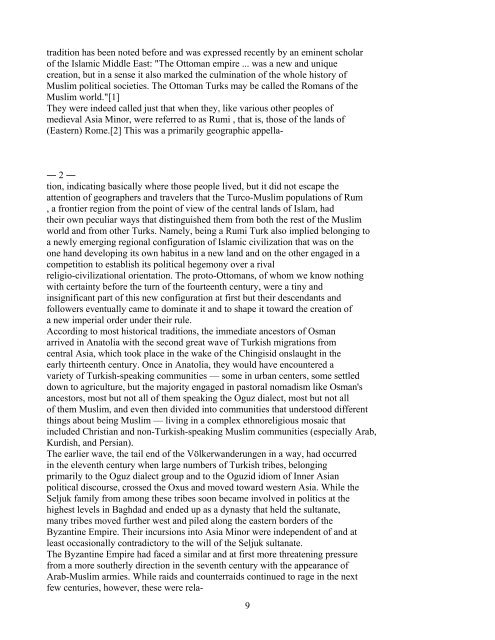Between Two Worlds Kafadar.pdf
Between Two Worlds Kafadar.pdf
Between Two Worlds Kafadar.pdf
Create successful ePaper yourself
Turn your PDF publications into a flip-book with our unique Google optimized e-Paper software.
tradition has been noted before and was expressed recently by an eminent scholar<br />
of the Islamic Middle East: "The Ottoman empire ... was a new and unique<br />
creation, but in a sense it also marked the culmination of the whole history of<br />
Muslim political societies. The Ottoman Turks may be called the Romans of the<br />
Muslim world."[1]<br />
They were indeed called just that when they, like various other peoples of<br />
medieval Asia Minor, were referred to as Rumi , that is, those of the lands of<br />
(Eastern) Rome.[2] This was a primarily geographic appella-<br />
― 2 ―<br />
tion, indicating basically where those people lived, but it did not escape the<br />
attention of geographers and travelers that the Turco-Muslim populations of Rum<br />
, a frontier region from the point of view of the central lands of Islam, had<br />
their own peculiar ways that distinguished them from both the rest of the Muslim<br />
world and from other Turks. Namely, being a Rumi Turk also implied belonging to<br />
a newly emerging regional configuration of Islamic civilization that was on the<br />
one hand developing its own habitus in a new land and on the other engaged in a<br />
competition to establish its political hegemony over a rival<br />
religio-civilizational orientation. The proto-Ottomans, of whom we know nothing<br />
with certainty before the turn of the fourteenth century, were a tiny and<br />
insignificant part of this new configuration at first but their descendants and<br />
followers eventually came to dominate it and to shape it toward the creation of<br />
a new imperial order under their rule.<br />
According to most historical traditions, the immediate ancestors of Osman<br />
arrived in Anatolia with the second great wave of Turkish migrations from<br />
central Asia, which took place in the wake of the Chingisid onslaught in the<br />
early thirteenth century. Once in Anatolia, they would have encountered a<br />
variety of Turkish-speaking communities — some in urban centers, some settled<br />
down to agriculture, but the majority engaged in pastoral nomadism like Osman's<br />
ancestors, most but not all of them speaking the Oguz dialect, most but not all<br />
of them Muslim, and even then divided into communities that understood different<br />
things about being Muslim — living in a complex ethnoreligious mosaic that<br />
included Christian and non-Turkish-speaking Muslim communities (especially Arab,<br />
Kurdish, and Persian).<br />
The earlier wave, the tail end of the Völkerwanderungen in a way, had occurred<br />
in the eleventh century when large numbers of Turkish tribes, belonging<br />
primarily to the Oguz dialect group and to the Oguzid idiom of Inner Asian<br />
political discourse, crossed the Oxus and moved toward western Asia. While the<br />
Seljuk family from among these tribes soon became involved in politics at the<br />
highest levels in Baghdad and ended up as a dynasty that held the sultanate,<br />
many tribes moved further west and piled along the eastern borders of the<br />
Byzantine Empire. Their incursions into Asia Minor were independent of and at<br />
least occasionally contradictory to the will of the Seljuk sultanate.<br />
The Byzantine Empire had faced a similar and at first more threatening pressure<br />
from a more southerly direction in the seventh century with the appearance of<br />
Arab-Muslim armies. While raids and counterraids continued to rage in the next<br />
few centuries, however, these were rela-<br />
9













